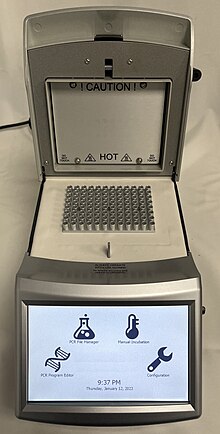Thermal cycler

The thermal cycler (also known as a thermocycler, PCR machine or DNA amplifier) is a laboratory apparatus most commonly used to amplify segments of DNA via the polymerase chain reaction (PCR).[1] Thermal cyclers may also be used in laboratories to facilitate other temperature-sensitive reactions, including restriction enzyme digestion or rapid diagnostics.[2] The device has a thermal block with holes where tubes holding the reaction mixtures can be inserted. The cycler then raises and lowers the temperature of the block in discrete, pre-programmed steps.
History


The earliest thermal cyclers were designed for use with the
Modern innovation

Modern thermal cyclers are equipped with a heated lid that presses against the lids of the reaction tubes. This prevents condensation of water from the reaction mixtures on the insides of the lids. Traditionally, a layer of mineral oil was used for this purpose. Some thermal cyclers are equipped with a fully adjustable heated lid to allow for nonstandard or diverse types of PCR plasticware.[3]
Some thermal cyclers are equipped with multiple blocks allowing several different PCRs to be carried out simultaneously. Some models also have a gradient function to allow for different temperatures in different parts of the block. This is particularly useful when testing suitable annealing temperatures for PCR primers.
References
- PMID 3203600.
- .
- ^ "The Most "Advanced" Thermal Cycler Yet - Get Informed". Get Informed. 2014-09-29. Retrieved 2017-05-31.
External links
- OpenPCR, an open-source PCR thermal cycler
- PCR Machine Service Provider (UK)
